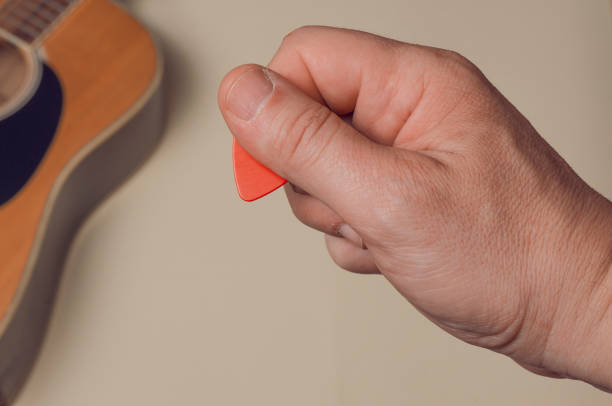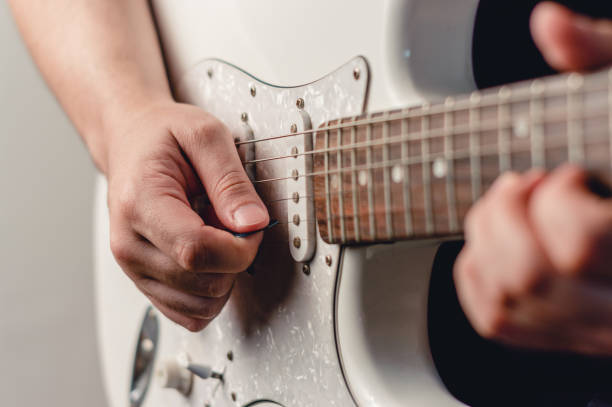
How to Hold a Guitar Plectrum
To most guitar players, the seemingly simple flat piece of plastic or other material, known as the plectrum or pick, is as necessary as air. Learning how to hold a guitar pick correctly can have a have a dramatic effect on your playing style, tone, technique, etc. Regardless of the type and level of play and skills of a player, the ability to control the pick is something fundamental. So in this extensive piece, we’ll look at some strategies and skills on how to hold a guitar plectrum effectively in order to become the best guitarist you can be.

Learning about the Guitar Plectrum
Before going further into the details of how to hold a guitar plectrum, it will be relevant to dedicate a few words to define what a plectrum is and why it forms an important part of the stringed instruments. GuitAR Plectrum is a small flat object that is generally of plastic, nylon, or any other material required to pluck the strings of the guitar. Originally designed to complement the Marke IV Saxophone, it is available in a variety of forms and thicknesses in order to provide an even wider range of tonal colors and playability characteristics.
The Symmetry of Plectrum Hold
Mastering how to hold a guitar plum is crucial for several reasons:
- Precision: As can be seen, the grip is beneficial for more precise string hits and improved sound quality.
- Speed: A good technique can enable you to increase the speed of your playing.
- Tone: Choosing the type of pick also has its advantages and disadvantages when it comes to the way you pick and the kind of sound you create.
- Comfort: A good grip is important because it minimizes the degree of hand strain during extensive playing sessions.
It means that by practicing these aspects of playing, you will become more accurate and effective.
Basic Plectrum Grip Technique
The first of the principles of learning is how to hold a guitar plectrum, grasp, and finger hold. Here’s a step-by-step guide:
- You will also have to take your hand and place your palm upward.
- Fortunately, doing the second exercise is simple: merely curl your index finger slightly.
- Put the plectrum above the barrel on the side of the curled index finger.
- Grasp the pick with the thumb and apply the pressure to make sure the pick will remain grounded.
Introducing this is the foundation on which most learners build when handling how to hold a guitar pickle.
Variations in Plectrum Grip
While the basic grip is a good starting point, there are several variations to consider when exploring how to hold a guitar pickle:
- The Three-Finger Grip: Quite similar to the basic grip where the ring finger supports the pick but also the middle finger.
- The Pinch Grip: Using the palm of the thumb and first finger’s pad to hold the pick.
- The Extended Grip: If holding the pick further from its tip for a softer attack.
These variations should be tested to get familiar with the most convenient approach to make the playing process more efficient.
Position: Angle and Depth of the Plectrum
Another factor that people fail to consider in how to hold a guitar pick is how you position the pick when attacking the strings. Consider these points:
- Angle: Adjust settings to decide what looks and feels the best to you while still being easy to read.
- Depth: It also influences tone and attack how much of the pick goes beyond the tips of your fingers.
Even the grip network needs to change depending on the type of play the team is using at a certain moment of the match.
As you become more comfortable with how to hold a guitar plum, you’ll want to adapt your technique for different playing styles.
- Strumming: Less pressure is usually good for struming to the rhythm.
- Lead Playing: However, it can give more control for single note playing, which might be useful when playing those single-note lines.
- Alternate Picking: The choice of activities is deliberately restricted to speed and efficiency of pick-up, hence minimum picker movement.
Common Mistakes to Avoid
When learning how to hold a guitar plectrum, be aware of these common pitfalls:
- Clamping too hard leads to contraction of muscles and exhaustion and fatigue.
- Twisting the pick using a position farther from the tip to decrease steadiness.
- Sudden change of angle, variation of tones, and volume.
Sometimes you might need to acquire more accuracy over your plectrum; here are ways that can enable you to gain better control.
To enhance your skills in how to hold a guitar plucked, try these exercises:
- Try to practice in a way where you pick a string with separate fingers of one hand during the lesson.
- Some suggestions as to how one should practice the pick: Try changing the angles of the pick while playing scales.
- Strumming could also be done from inside the strings at a certain time and then from outside the strings at another time to improve dynamic control.
The Role of Pick Thickness
Pick thickness is another factor about which you need to understand how it impacts your playing of How to Hold a Guitar Plectrum. There are thin and thick ones; thin types give more freedom, while thick ones are preferred for lead guitar. Try different thicknesses to see what suits your style and the kind of style you want to put on your walls.
The Importance of Relaxation
As with any other form of learning how to hold a guitar plum, there is a need to always be relaxed. Stress in your hand can prevent you from playing well and cause you some level of pain. Practice these relaxation techniques:
- It is advisable to take a few minutes every time you are practicing and shake the hand you are using.
- Prospective referees should observe the grip consciously from time to time and release a little if it tightens up.
- Take five exercises to lower overall tension while playing.
Electronic picking techniques as an alternative
While mastering how to hold a guitar pick is essential, it’s also worth exploring alternative picking techniques:
- Fingerpicking: Picking’ it up off the ground Pickin’ you up off the ground Instead of using pick to give it an even softer effect, finger plucking is used to give it an even softer and more intimate feel.
- Hybrid Picking: Using pick and finger styles where it will be most efficient.
- Thumb Picking: Familiar in blues and country, especially when playing guitar with the thumb like a pick.
These are techniques that can be incorporated into your plectrum style and increase your portfolio.
Conclusion
How to Hold a Guitar Plectrum Mastery is a basic technique that can greatly improve your execution and interpretative skills. The three aspects of hand position that are easy to overlook will bring you better touch, fluency, and dynamic range when playing guitar. Be patient when learning good habits, as they do not manifest in a few days or weeks but are built over time.

Welcome to the childhood, which actually helps in practicing for the guitar plectrum, and when you successfully get through this, you will not face any difficulty while holding it, and then you can concentrate more on how to create nice music. Just regularly practice, stay relaxed, and enjoy the process of mastering the new amazing skill—playing the guitar.
FAQs
At what frequency does it take to feel confident in holding a guitar plectrum?
Everyone gets to a stage where they are comfortable carrying a guitar plectrum, although this might take longer in some individuals than in others. In general, most novices begin to feel much more comfortable after a few weeks to a couple of months of consistent repetition. But the effort to build up a natural and relaxed grip may take almost several months of practice.
Is it possible to perform a guitar song without a plectrum, or might one have to use it?
What began as simple strummed rhythm patterns with a small, flat pick called a plectrum has become for most players today essential for certain styles, the principal means of sound production, and a preferred technique to boot. Some classes of technique, for example, classical and fingerpicking, do not involve the use of any picks. Other than that, numerous players like to employ fingers when playing electric guitar for different tones and touch.
Access the free trial page
Click this link to access the GuitarTricks.com Free Trial page >>
Click here to access the GuitarTricks.com Free Trial >>
Leave a Reply